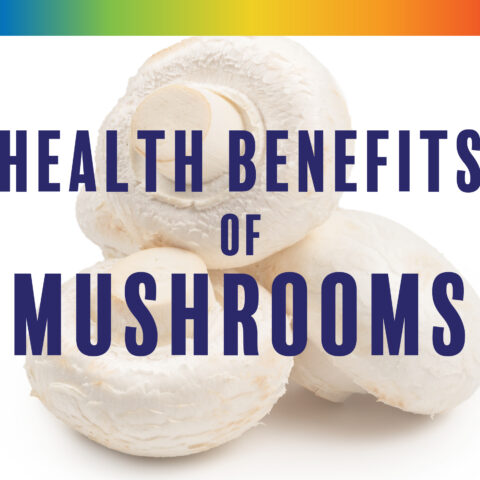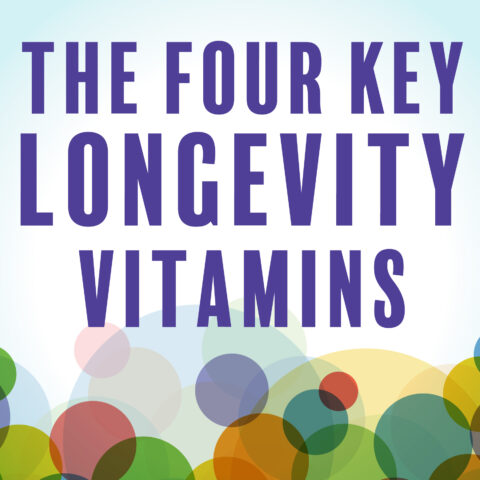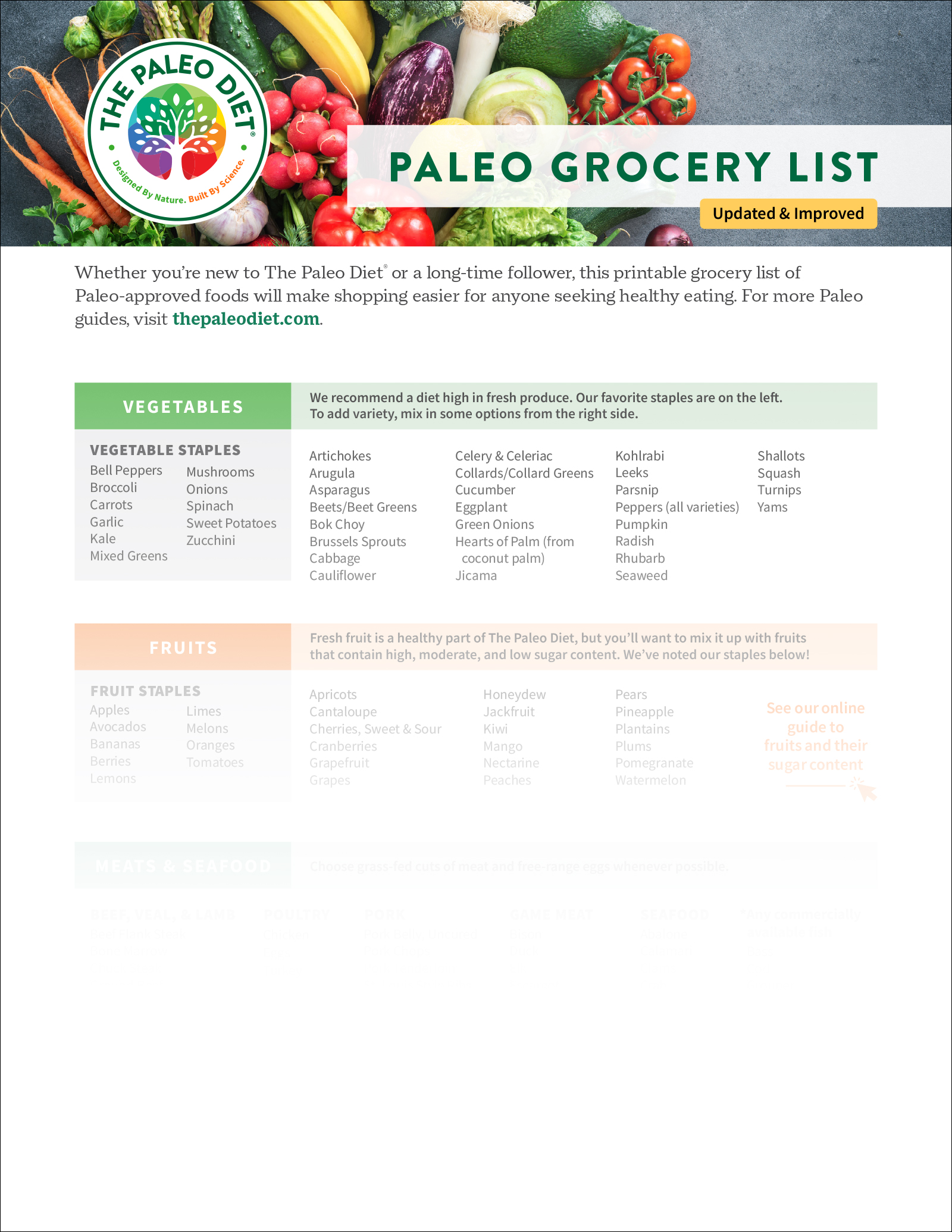Why Do We Age?
Loren Cordain, Ph.D., M.S., Mark J. Smith, Ph.D., Ph.D., Trevor Connor, M.S.

In Paleo for Life, our team focuses on the causes of aging from a nutritional perspective. The full list of aging factors could be its own book, but from a nutrition perspective, below are five of the most important causes of aging that the antiaging superfoods in Paleo for Life can improve.
This article is an excerpt adapted with permission from the book Paleo for Life: Superfoods to Slow Aging, Boost Longevity, and Enhance Your Well-Being by Dr. Loren Cordain, Trevor Connor, and Dr. Mark J. Smith. In this groundbreaking guide, the leaders of the Paleo nutrition movement reveal the longevity superfoods that can help you live longer and better, starting today.
Oxidative Stress: How Unstable Oxygen Molecules Wreak Havoc on Healthy Cells
Millions of years before the Paleolithic era, life on Earth was limited to single-cell organisms. These cells could only produce energy anaerobically (without oxygen). While this way of producing energy sustained single-cell life, it wasn’t very efficient and couldn’t support multicellular organisms. Then an extraordinary event happened. Called the Great Oxidation Event by scientists, this was a period when there was such a dramatic increase in oxygen that it became a major component of the Earth’s atmosphere.
Using this now readily available oxygen, cells could produce energy more efficiently and in a far greater capacity. Oxygen allowed cells to break down fats for fuel, which released 20 to 30 times more energy than anaerobic energy production and ultimately allowed multicell organisms to exist. This had many advantages, but it came at a substantial cost. While anaerobic organisms could die from mutations or changes in their environments, they could otherwise live extremely long lives; in essence, they were immortal. In 2005, for instance, scientists found viable 35,000-year-old protozoa in the Russian tundra.
We could argue that aging was the price of aerobic metabolism, since oxygen is highly damaging to cells. You probably have not heard of “reactive oxygen species” (ROS). You’ve surely heard of antioxidants, which are so valuable partly because they address the damaging ROS in our bodies, and “free radicals,” which are not the same as ROS.
There are many types of ROS, but the one thing they have in common is unstable oxygen molecules. This means the oxygen has an unpaired electron, so the oxygen “steals” electrons from the molecules that make up DNA, proteins, and other components of the body, potentially causing damage to healthy cells and accelerating aging through oxidative stress. Our ability to manage this oxidative stress is a key factor in our aging.
Much of the ROS in our bodies is produced by our own mitochondria, the organelles found inside almost every cell of the human body where aerobic metabolism occurs. Mitochondria produce a lot of ROS, but luckily, the mitochondria have multiple membranes that help contain them. As we age, however, mitochondria can stop functioning as effectively, allowing more ROS to spill out into our systems and contributing to conditions like inflammation. While our mitochondria are the major natural source of ROS, toxins like cigarette smoke, medication, and radiation can also contribute to oxidative stress.
This free radical theory of aging was originally proposed by Denham Harman in 1956. There have been many challenges and revisions to the theory since, but the collective evidence indicates that the leakage of ROS by mitochondrial membranes represents a major player, if not the major player, in the pathophysiology of aging. Luckily, many foods featured in The Paleo Diet®—which we’ll highlight throughout the book—are full of particularly potent antioxidants that can reduce the potential harm oxidative stress can do to our bodies.
Telomere Length: One of Your Most Important Biomarkers of Aging
Another important factor in aging is the shortening of our telomeres, the loop-shaped DNA protein structures found at the end of every chromosome in our DNA. This extra material is designed to protect our DNA by preventing our chromosomes from degrading. It’s like putting tape at the end of a rope to keep it from fraying. But if telomeres become damaged or shortened, the protective loops can open and activate a DNA damage response that leads to cell death and age-related disease.
Your telomeres shorten naturally with aging. Every time a cell reproduces, the chromosomes split and duplicate. The problem is that it’s not a perfect process. Some of the material at the ends of the chromosomes can be lost each time they split.
That’s fine if it’s the telomeres that are lost, just like it’s OK if the tape is damaged as long as the rope remains intact. However, if the telomeres continue to shorten as cells replicate again and again through the decades, eventually there will be no telomeres left, and critical genetic material will start to erode. This process prevents our cells from effectively performing their functions, leading to age-related conditions like inflammation, mitochondrial dysfunction, and serious diseases like cancer.
Telomere length has become such an important theory to explain why we age that scientists often measure the telomere length in human blood lymphocytes as a biomarker of aging and mortality. For instance, older people with shorter telomeres are at three times the risk of dying from heart disease and up to eight times the risk of dying from infectious diseases. There are many ways to maintain healthy telomere lengths, including exercise, consuming certain foods, and reducing salt.
Nutrient Sensing: The Life Cycle of Your Cells Impacts Your Longevity
A steady supply of glucose is essential to our bodies. This may seem surprising if you think about how our hunter-gatherer ancestors didn’t always have a lot of carbohydrates available to them, especially if they lived in colder climates where they could forage plant foods only in warmer months and were otherwise limited to mostly animal foods. However, evolution has created various important mechanisms in our bodies to regulate our glucose levels and ensure that we have an adequate glucose supply even when we can’t get it from our diets.
You’re probably familiar with the protein insulin, which regulates glucose after a meal. It is just one of several proteins in our bodies that respond to glucose levels in our blood. These other glucose-sensing proteins instigate a host of processes in our bodies depending on how much glucose is available to us. This helps our bodies manage times of low and high carbohydrate availability.
One of the most important processes controlled by the glucose level in our bodies is the life cycle of our cells. When glucose levels are high, cells proliferate. When glucose levels drop, cells stop proliferating. It’s the body’s way of saying, “There isn’t enough fuel right now, so stop growing.” And if glucose levels get very low, cells can enter programmed cell death. That sounds bad, but for optimal health, our cells actually need to go through all three of these stages regularly.
To emphasize this point, let’s look at what happens when cells get stuck for too long in any of these phases. It’s important for cells to have periods when they stop proliferating because that’s when they perform DNA repair and other critical functions. But, if levels stay low for a long time, cells become “senescent,” meaning they can start to deteriorate. Excess cellular senescence is a hallmark of poor aging.
So, does this mean that we should try to keep our cells in a constant state of proliferation to avoid senescence? Absolutely not. Constant proliferation is a feature of cancer cells, which are also known as “immortal cells” because they never stop reproducing or enter programmed cell death.
For over 100 years, we’ve been aware of a phenomenon in cancer cells called the Warburg Effect. It’s a complex process, but what it boils down to is that cancer cells mostly lose their ability to use fat for fuel and rely almost exclusively on glucose. As a result, cancer cells maintain a constant high-glucose environment around them.
In fact, it’s often not the cancer cells that directly kill the patient, but cachexia—the wasting of the body as its fuel (glucose) is stolen from the rest of the body by these very hungry cancer cells. By maintaining a constant high-glucose environment, cancer cells stay in a constant state of proliferation. That’s clearly detrimental to our health.
Does this mean that we should focus on a ketogenic diet and keep our glucose levels very low at all times? Ketosis has been shown to help protect against cancer and neurodegeneration in the short run, but its promotion of senescence and cell death can speed aging in the long run. That’s why we don’t recommend eating keto long term.
Many nutritionists talk about the benefits of metabolic flexibility, which is just a fancy term for letting your body fluctuate between high and low glucose states to encourage the full cell cycle. Like our ancestors, we should have periods when we eat a higher carbohydrate diet and periods when we eat fewer carbohydrates.
We recommend intermittent periods of higher carbohydrate intake and short periods where you’re eating ketogenic, or almost ketogenic. This way, you’ll promote all stages of the cell cycle, which in turn supports cellular and mitochondrial health, and ultimately better aging. Being metabolically flexible promotes a healthy cell cycle, and science backs that up.
Chronic Inflammation: A Nearly Invisible but Powerful Contributor to Disease
Dee Ann was visiting her parents for the Christmas holidays in 2004 when her life changed literally overnight. At 42, she was active and fit from running, weightlifting, and biking. She’d gone out for her regular run on December 26, but woke up on December 27 “feeling like I had rocks in my feet.”
She saw her doctor when she returned home, who suggested that she “exercise more.” Dee Ann knew she was already exercising far more than most women her age, so she sought a second opinion. The next doctor said, “I think you have rheumatoid arthritis,” a chronic inflammatory disease that causes joint pain, stiffness, and decreased movement over time.
When blood tests confirmed the diagnosis, the first rheumatologist Dee Ann saw was blunt about her prognosis. “He said my condition was so severe that I’d probably be in a wheelchair in five years and could be dead in ten.”
Dee Ann immediately began researching her condition to see what treatments were available. In exploring foods that might alleviate the pain and swelling in her joints, she discovered The Paleo Diet.
“I went cold turkey Paleo twenty years ago,” she says. “The results have been astonishing. I don’t have any of the fatigue or brain fog you can get with autoimmune diseases, and I have much less inflammation than most people with this condition.”
So much less inflammation, in fact, that today, at 61, Dee Ann continues to enjoy an active life, from refinishing doors for her farmhouse to volunteering with the Red Cross and working with a raptor rehabilitation group to rescue and rehabilitate injured owls, hawks, and other birds of prey.
“Paleo is all about eating what nourishes my mind and body,” she says. “It’s the best thing I could have done for myself.”
While scientists haven’t yet described one clear pathway linking chronic inflammation to aging the way they have with telomere length and the cell cycle, as Dee Ann discovered firsthand, chronic inflammation may be the sneakiest contributor to aging because of the many mechanisms through which it negatively affects our bodies. Reducing inflammation is perhaps one of the most beneficial impacts that diet can have on helping us age well.
Let’s start by defining the difference between inflammation and chronic inflammation. We all know what inflammation looks like on the outside: If you stub your toe or bang your knee, the area will swell and turn red. That’s a sign that your body is sending immune cells to clean up the damage. Inflammation is the word we use to describe the process where our immune systems ramp up to fight a virus or bacterial infection, or to repair damage. When our bodies are healthy, it is a temporary condition that addresses the issue and then fades away.
On the other hand, chronic inflammation—which is often caused by poor diet and lack of exercise—is invisible, but it’s linked to almost every chronic disease of aging, including autoimmune conditions like rheumatoid arthritis, cancer, cardiovascular disease, diabetes, and neurodegeneration. Chronic inflammation has also been closely linked to oxidative stress, telomere shortening, and the other factors we’ve discussed here that are involved in the aging process.
Chronic inflammation is the result of your immune system acting as if the body is under attack when it isn’t. In response to a variety of issues, the immune system releases small proteins called cytokines. Some cytokines attract immune cells and activate key inflammatory processes, while others calm the immune system down. Cytokines are essential messengers that direct our immune systems, but chronically elevated inflammatory cytokines can lead to damage to healthy cells.
When cytokines are released in response to a viral or bacterial invader, they attract immune cells, which kill the invaders. Collateral damage to nearby cells is an unfortunate but accepted sacrifice. It’s critical that the immune system is activated to deal with a threat and then stand down after the threat has passed. In a healthy body, inflammatory cytokines then give way to the anti-inflammatory cytokines and the immune system calms down.
Bad things happen when the immune system remains activated. In fact, it’s been shown that chronic elevation of a particularly damaging immune cell called TH17 precedes almost every autoimmune disease. Some of the foods in our modern diet are remarkably effective at promoting highly inflammatory cytokines and keeping them elevated. Wheat, and particularly gluten, has multiple mechanisms to activate TH17 cells. Of the over 100 known autoimmune diseases in humans, the trigger has been identified for only two. In both cases it was gluten.
Inflammation can also be caused by senescent cells—those cells that stop multiplying but never die or get washed out of your body. As we age, our immune systems begin deteriorating, and other bodily systems may become weakened, which means these junk cells can accumulate and damage otherwise healthy cells, causing chronic inflammation.
In a large-scale meta-analysis on diet and chronic disease, The Paleo Diet was by far the most effective diet at reducing biomarkers of inflammation with a SUCRA score of 87%, reinforcing existing science that shows The Paleo Diet is a strongly anti-inflammatory diet.
SUCRA (surface under the cumulative ranking curve) is a well-known research tool used in meta-analysis studies. The SUCRA number is a score from 0 to 100% that compares all the treatments included in a study or analysis. Higher SUCRA scores indicate that a treatment is more likely to be effective than lower-scored treatments.
The DASH diet, which is designed to lower blood pressure through foods lower in sodium and higher in potassium, magnesium, and calcium, came in second to The Paleo Diet, at 71.3%. The Mediterranean diet, which includes foods associated with inflammation like processed grains and legumes, earned a SUCRA score of 58.1%, showing that it is significantly less effective than The Paleo Diet at addressing inflammation.
Besides highlighting the power of The Paleo Diet, this meta-analysis had one other important revelation: The U.S. government’s nutritional guidelines aren’t very good for you. The government-recommended dietary guidelines scored just 48.5% on the SUCRA scale. In other words, if you eat according to the “official” recommendations of the U.S. government, you’ll be more at risk for chronic disease as you age. Likewise, a plant-based diet was ranked almost as low, coming in at just 49.3%.
Epigenetic Changes
A biology text might illustrate our DNA as nice X’s and Y’s, but in actuality, our DNA looks more like a giant ball of string with only a small part of each chromosome exposed at the surface. Which parts of the chromosomes are exposed can greatly impact how our cells function. Scientists believe that how the balls of DNA are wound up changes as we age to emphasize some genes in our youth and others as we grow older.
For example, the genes that allow us to digest milk are exposed when we are infants but are buried deep in the ball later in life and effectively turned off. What this means is that epigenetic changes—or changing how the chromosomes are bunched up—may be a key factor in how we age.
The most important takeaway is this: Your chronological age really is just a number. Your body will react to the foods you eat, so if you eat the clean, healthy, whole foods of The Paleo Diet and continue engaging in activities that exercise your mind and body, you’ll increase your chances of living a healthier, happier, more energetic life. Plant foods in particular play an essential role in helping you age not only gracefully, but energetically, because plants contain some of our most important longevity nutrients.
Paleo for Life
Paleo for Life reveals how your favorite foods and flavors can help you live a longer, healthier life.
Discover the most potent antiaging superfoods and see how what’s on your plate connects to how you feel each day. Includes a two-week meal plan and 50+ superfood recipes.
Live longer and better, starting today, with Paleo for Life.




